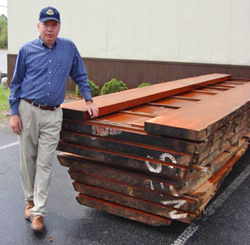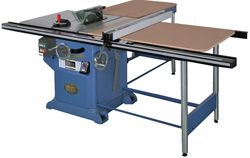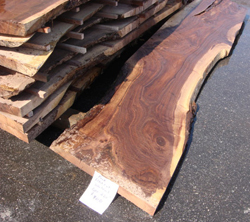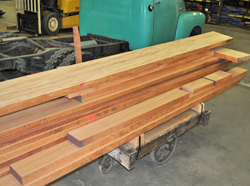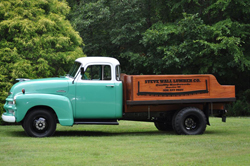
After 11 years of teaching middle school social studies and gym, Steve Wall was ready for a change. But he never expected that it would come in the form of 4,000 board feet of pristine cherry lumber.
“I had done some woodworking in my childhood, mostly in shop class at school. My father and grandfather were decent carpenters, and they got me a hammer and a bag of nails. I hammered every board around,” Wall recalls.
It wasn’t until he was a teacher, though, that the woodworking bug took hold again. His school had a nice woodshop, and Steve spent time with the shop teachers, who also were accomplished woodworkers. “I started making mantle clocks in my spare time while I hung on to teaching. Those small projects taught me how to improve my techniques and learn to read plans.”
Then a curious turn of events happened. Steve’s wife’s family owned a plantation farm of several thousand acres, much of it forested. When some enormous cherry trees were felled on the property, an aunt offered them to Steve, who had it cut into board lumber.
“That cherry was red as a watermelon, and a lot of the boards were 30 in. wide. In these parts of North Carolina, you don’t see cherry trees that big, so it might have been virgin timber. Beautiful stuff!” However, several thousand board feet were more than he needed for his projects, so Wall started selling it out of his backyard. Word of mouth spread, and the customers started coming. That’s when the light of new opportunity started to burn.
Steve started buying local lumber in various species and selling it. “There were lots of small ‘hand mills’ at the time in our area cutting lumber. I got to know those sawyers, and then I started running a weekly route to buy up what they had available.”
Processing that lumber for his own use, though, was tough to do without better woodworking machinery than he owned. Steve wanted a Belsaw machine, but the price was prohibitive. Eventually he toyed with the possibility of becoming a Belsaw dealer instead, so he could take advantage of dealer discounts while the tool sales income supported the growing wood business.
“Once I got connected with RBI/Belsaw, they came out with a constant-tension scroll saw. They asked me to do a motel showing of the new tool, and lots of people came out to see me use it. I became very skilled with it, which really helped sell the tool. Those machines sold like crazy, so before long I was traveling up and down the East Coast selling scroll saws and planers. That income was as important to me as the wood business.”
Steve recalls times when he nearly filled the family home with his scroll saw inventory, sometimes having a hundred or so on hand. He bought them in volume to get the best discount, knowing that he could sell them at a brisk pace. In addition to tool sales, Wall also spent some time tinkering with a new tool idea for RBI. He patented the design for RBI’s Joint Machine, a horizontal router indexed to make dovetails and other joinery.
His success as an RBI dealer eventually got Steve connected with SCMI, where he became the first U.S. dealer of Mini Max woodworking machinery.
Steve Wall Lumber Company carries more than 20 different native hardwoods and softwoods, and 36 exotics, plus a full line of hardwood plywood to match the lumber species. Baltic birch and a variety of turning blanks are also available. While most of the lumber doesn’t come from local sources these days, Steve does still travel to lumber companies from time to time to hand-pick specific logs, especially for two species that he considers to be company specialties: unsteamed walnut and ambrosia maple. And, he’s very selective about the logs he chooses. “Sometimes I buy only 25 logs or so but look at more than a thousand of them … I want that great figure. I want to find the diamonds in the rough.”
Wall says the key to selling retail lumber these days is diversification. It’s a business model he’s followed since the start, and it’s been key to weathering the recent recession. “I used to sell 65 to 70 percent of my inventory by mail order to schools, military bases and overseas. But now freight has become so expensive that sometimes the shipping costs more than the wood does.”
While 50 percent of sales are still shipped, Steve supplements online and walk-in sales with an on-site millwork shop adjacent to the lumber warehouse, where employees make high-end flooring, moldings and baseboard. Wall also now offers CNC routing services for customers who want complex shaped parts or those who are interested in custom signage. He’s also opened a wholesale lumber program, and he’s a primary supplier of ambrosia maple turning blanks to a leading woodworking store chain.
Steve admits lumber sales are rebounding these days, but they aren’t what they were in the years prior to 2008. One of the bigger growth areas has been the prison industry. The company offers 20 board foot bundles of lumber, which are cost-effective to ship, and they are appealing to inmates who have access to the woodworking and craft shops in a number of penitentiaries. “We get a bunch of those orders every week.” He’s also seeing an uptick in woodworkers looking for live-edge wood to use as mantels and bar tops. Many of the walnut logs Wall buys are sawn into slabs or board lumber with the natural edges still intact.
Steve also continues to be a tool distributor for Oliver Machinery, carrying the full woodworking line. “Once again, I became an Oliver dealer in order to get good deals,” Wall says. He was one of the first dealers who signed on when Oliver Machinery reorganized back in 2002.
When he’s not running the business from his office or forklifting a load of lumber around the warehouse floor, Steve tries to keep a project or two going in the company shop. Recently, he fully restored a 1954 Chevy 1 Ton Truck, complete with an African mahogany bed. He’s proud of a paneled “man cave” he built in the basement of his home, and a 1923 Ford truck is next up for complete restoration. “The cab, bed and rails will be made completely from walnut,” Wall says. “It should be a big hit with customers when we take it on the road to shows.”
After more than 33 years in what has certainly been an evolving lumber business, Steve says it’s still exciting to come to work. “I love to meet woodworkers who have that special spark for our craft. Some of our customers travel great distances to visit us, even stopping by while on vacation. We’re always happy to take the time to talk woodworking with them or offer some advice.”
And, Steve might even help them find a diamond or two to take home.
